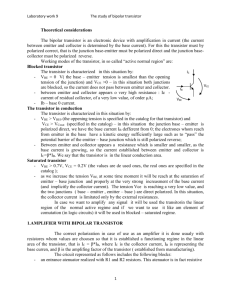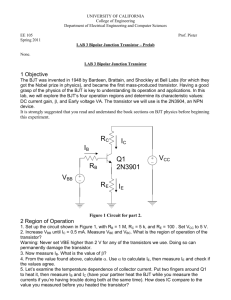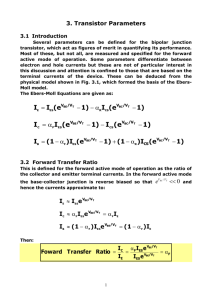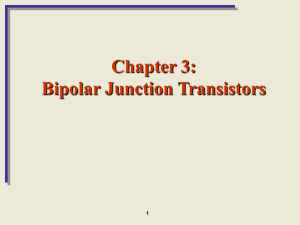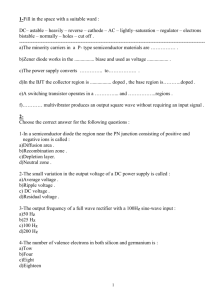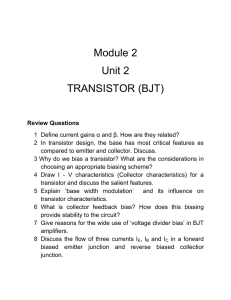Base Bias
advertisement
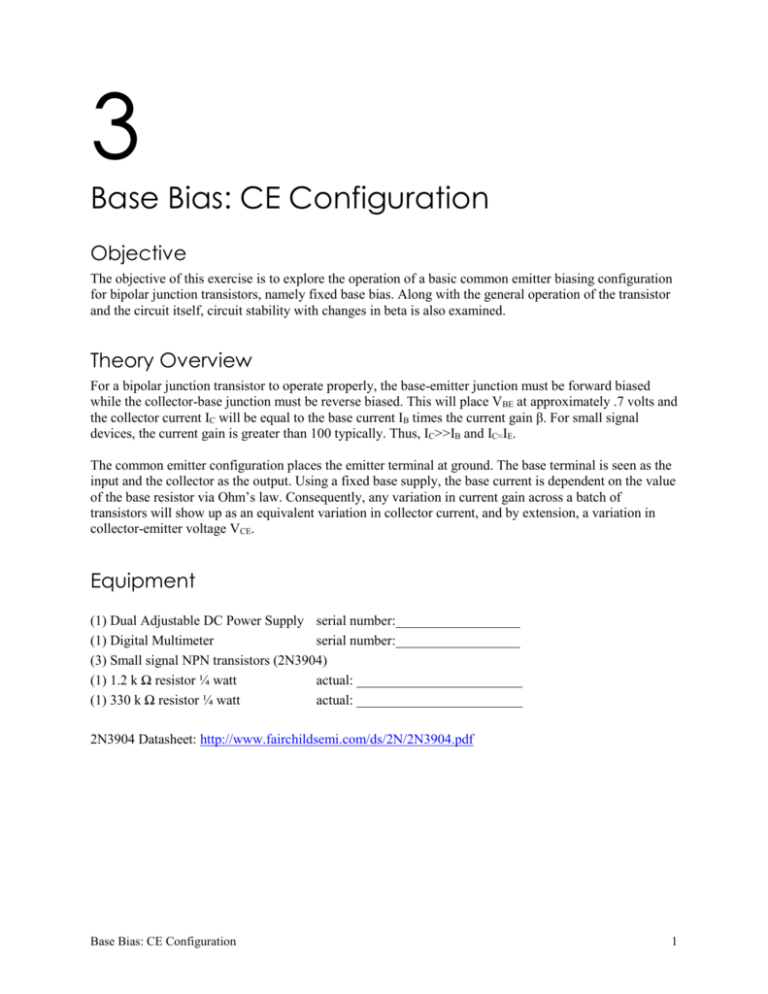
3 Base Bias: CE Configuration Objective The objective of this exercise is to explore the operation of a basic common emitter biasing configuration for bipolar junction transistors, namely fixed base bias. Along with the general operation of the transistor and the circuit itself, circuit stability with changes in beta is also examined. Theory Overview For a bipolar junction transistor to operate properly, the base-emitter junction must be forward biased while the collector-base junction must be reverse biased. This will place VBE at approximately .7 volts and the collector current IC will be equal to the base current IB times the current gain β. For small signal devices, the current gain is greater than 100 typically. Thus, IC>>IB and IC≈IE. The common emitter configuration places the emitter terminal at ground. The base terminal is seen as the input and the collector as the output. Using a fixed base supply, the base current is dependent on the value of the base resistor via Ohm’s law. Consequently, any variation in current gain across a batch of transistors will show up as an equivalent variation in collector current, and by extension, a variation in collector-emitter voltage VCE. Equipment (1) Dual Adjustable DC Power Supply serial number:__________________ (1) Digital Multimeter serial number:__________________ (3) Small signal NPN transistors (2N3904) (1) 1.2 k Ω resistor ¼ watt actual: ________________________ (1) 330 k Ω resistor ¼ watt actual: ________________________ 2N3904 Datasheet: http://www.fairchildsemi.com/ds/2N/2N3904.pdf Base Bias: CE Configuration 1 Schematics Figure 3.1 Procedure A Quick Check 1. A quick and easy way to determine if a transistor is damaged is through the use of the resistance (or diode) function of a multimeter. The multimeter will produce a small current in order to determine the connected resistance value. This current is sufficient to partially forward or reverse bias a PN junction. Thus, for an NPN device, placing the red lead on the base and the black lead on the emitter and collector in turn will produce forward bias on the junctions and the meter will show a low resistance. Reversing the leads will create reverse bias and a high resistance will be indicated. If the leads are connected from collector to emitter, one of the two junctions will be reverse biased regardless of lead polarity, and thus, a high resistance is always indicated. Before proceeding to the next step, check the three transistors using this method to ensure that they are functioning. (Note: some multimeters include a “beta checker” function. This may also be used to determine if the devices are good but the beta value produced should not be considered precise as the measurement current and voltage are most likely different from the circuit in which the transistor will be used.) Base Bias 2. Consider the circuit of Figure 3.1 with Vbb = 11V, Vcc = 15V, Rb = 330 k and Rc = 1.2 k. Assume VBE = .7 volts. Further, assume that beta is 150 (a typical value for this device in this application). Calculate the expected values of IB, IC and IE, and record them in the “Theory” columns of Table 3.1. Note that the theoretical values will be the same for all three transistors. 3. Based on the expected value of IC, determine the theoretical value of VCE and record it in Table 3.2. Also, fill in Table 3.2 with the typical (theoretical) beta value of 150. 4. Build the circuit of Figure 3.1 with Vbb = 11V, Vcc = 15V, Rb = 330 k and Rc = 1.2 k. Measure and record the base, collector and emitter currents, and record them in the first row of Table 3.1. Base Bias: CE Configuration 2 Determine the deviations between the theoretical and experimental currents, and record these in Table 3.1. 5. Measure the base-emitter and collector-emitter voltages and record in the first row of Table 3.2. Based on the measured values of base and collector current from Table 3.1, calculate and record the experimental betas in Table 3.2. Finally, compute and record the deviations for the voltages and for the current gain in Table 3.2. 6. Remove the first transistor and replace it with the second unit. Repeat steps four and five using the second row of Tables 3.1 and 3.2. 7. Remove the second transistor and replace it with the third unit. Repeat steps four and five using the third row of Tables 3.1 and 3.2. Design 8. One way of improving the circuit of Figure 3.1 is to redesign it so that a single power supply may be used. As note previously, the base current is largely dependent on the value of VBB and RB. If the supply is changed, the resistance can be changed by a similar factor in order to keep the base current constant. This is just an application of Ohm’s law. Based on this, determine a new value for RB that will produce the original IB if VBB is increased to the VCC value (i.e., a single power supply is used). Record this value in Table 3.3. 9. Rewire the circuit so that the original RB is replaced by the new calculated value (the nearest standard value will suffice). Also, the VBB supply should be removed and the left side of RB connected to the VCC supply. Measure the new base current and record it in Table 3.3. Also determine and record the deviation between the measured and target base current values. Multisim 10. Build the original circuit in Multisim. Run a single simulation and record the IB, IC, IE and VCE values in Table 3.4. Data Tables Transistor IB Theory IB Exp %D IB IC Theory IC Exp %D IC IE Theory IE Exp %D IE 1 2 3 Table 3.1 Base Bias: CE Configuration 3 Transistor VBE Thry VBE Exp %D VBE VCE Thry VCE Exp %D VCE β Theory β Exp %D β 1 2 3 Table 3.2 Calculated RB Actual RB Used IB Measured % Deviation IB Table 3.3 IB Multisim IC Multisim IE Multisim VCE Multisim Table 3.4 Questions 1. Are the basic transistor parameters borne out in this exercise? That is, are the approximations of VBE=.7 and IC=IE valid? 2. Is the typical beta value of 150 highly accurate and repeatable? 3. Which circuit parameters are affected by beta changes? Which parameters appear to be immune to changes in beta? 4. Comparing Tables 3.1 and 3.2, is there a notable pattern between the deviations for beta and collector current? Why/why not? 5. In the circuit of Figure 3.1, what must RB be set to if VBB = 5V and the desired base current is 10 µA? Base Bias: CE Configuration 4



